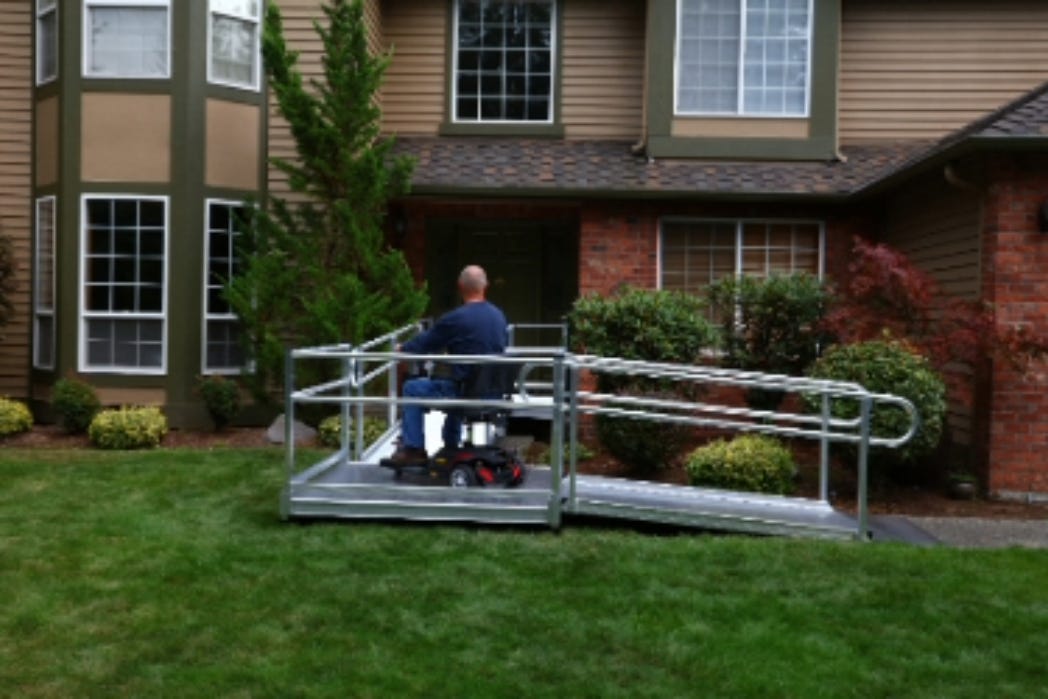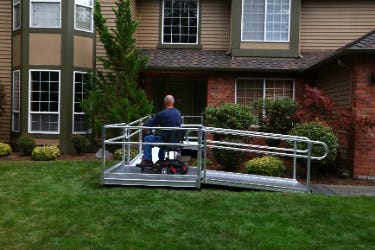
Navigating the world of wheelchair ramps can feel daunting at first– what size do you need your ramp to be? What material? How do you know if your ramp meets ADA guidelines?
If you’re unsure of where to start, we highly recommend considering modular wheelchair ramps. These ramps can be highly flexible to your individual, changing needs and offer a balance of cost, durability, and ease of use. They are a great option for both business and residential use.
In this guide, we’ll walk you through everything you need to know about how to buy a modular wheelchair ramp.


Modular Wheelchair Ramp Material
Most modular wheelchair ramps are made from lightweight aluminum. Aluminum ramps are easy to move and install, durable, and rust and weather resistant. They require minimal maintenance and can last for decades, making them an excellent all-around choice.
Benefits of Modular Wheelchair Ramps
- Customizable to fit your space: These ramps can adapt to fit your exact space. They can be customized for any home or business, without the expense of hiring a contractor.
- Easy installation: Depending on your ramp size, most can be easily installed within 1-3 hours with minimal tools. Installation is straightforward and can be done yourself. Because they are not classified as a permanent structure, these ramps generally do not require a building permit to install.
- Portable: Moving? No problem. Modular ramps can be disassembled, moved, and reinstalled at a new location with minimal effort.
- Durable: As most are made from aluminum, modular ramps are highly durable and require minimal maintenance. They can generally support up to 700-1,000 lbs.
- Great for any timeframe: Because of their flexibility, modular ramps can be used for both short-term and long-term accessibility needs.
Also see our range of:
How to Order a Modular Wheelchair Ramp
So you want to order a modular wheelchair ramp– where do you start? When ordering your ramp, you’ll need to select from a variety of brands, ramp lengths, platforms, and more.
Step 1: Measure Your Space
Evaluate the space where you’ll be installing your ramp.
Ramp rise: How high does your ramp need to ascend? ADA guidelines recommend 12 inches of ramp length for every inch of vertical rise. By measuring how high your ramp will need to be, you can calculate the minimum length needed for your ramp.
Ramp space: How much space do you have to install the ramp? You can opt to install a single long ramp, or, if you have a shorter length of space available, connect multiple ramp sections together in a switchback design.
Be sure to take out a tape measure and record the exact dimensions of your space.


Step 2: Plan Your Ramp Configuration
Modular ramps are built from connecting different ramp lengths and platforms together. Now that you know exactly what length your ramp needs to be and the space available to you, it’s time to create your ramp’s layout.
Take out a pencil and paper, and begin sketching out your ramp’s configuration.
Typical ramp configurations are the following:
- Straight ramp: A fully straight ramp with no platforms or turns.
- L-Shape: A ramp with a single 90-degree turn, connected by a platform.
- U-Shape: Also known as a switchback ramp, a U-shape ramp has parallel ramp lengths connected by a landing platform that allows users to make a 180-degree turn. These are great for spaces where a significant ramp height is required.
Once you know what ramp layout you prefer, be sure to write down the length that each ramp length needs to be. This is also a good time to consider ramp width, as modular ramps can come in either a 36” or 48” width.
If you need any assistance with planning your modular ramp layout, many retailers and wheelchair ramp providers will be able to help you in this process. At Med Mart, we’d love to help you plan out your modular wheelchair ramp needs.
Step 3: Consider Any Extras
Customization doesn’t end with ramp length and width– many modular ramps come with a variety of add-ons and extra customization options.
For example:
- Handrails: Choose from 2-line or vertical picket handrails.
- Stairs: Some modular ramps come with a set of stairs that you can install alongside the ramp.
- Gates: Need to close off access to the ramp sometimes? Choose a model with a gate to keep your ramp secure and closed.
- Surface: Consider additional options for traction or a non-slip surface.
Step 4: Order Your Ramp
Place an order for your new modular wheelchair ramp! Here at Med Mart, we have a wide variety of modular wheelchair ramps for sale– you can browse our catalog to find which brand works best for you.
When ordering your ramp, you can select your desired ramp lengths, platforms, and more.
Step 5: Install Your Modular Wheelchair Ramp
Once delivered, you can opt to set up your wheelchair ramp yourself or pay for professional installation. Most ramps can be easily installed within 1-3 hours, depending on size and complexity.
Once installed, be sure to test your new ramp to check for stability. Then you’re all set! Enjoy the new safe access provided to your home or business.
Modular wheelchair ramps are a flexible way to create accessible entrances in almost any commercial or residential space. If you need any assistance planning out or selecting a modular ramp
our team of experts are available to help via phone, chat, or email.
